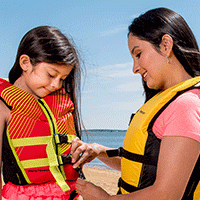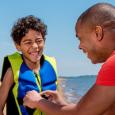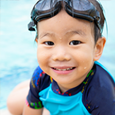Ask an Expert: How to find the right life jacket?

Q. How can I be sure I have the right life jacket for my child?
Great question! Making sure kids are wearing the right life jacket is one of the best ways to keep them safe while boating and participating in water activities. Here are a few tips to remember when choosing a life jacket:
Read the label
Check the label printed on the life jacket and read the product description. Choose a life jacket (also called a personal floatation device or PDF) that is approved by the U.S. Coast Guard (USCG) and make sure it is appropriate for your child’s weight and intended water activity.
Remember, swimming aids and toys such as water wings and inflatable water rings do not prevent drowning and should not be used in place of USCG-approved life jackets.
Know the different types
There are different types of life jackets intended for a variety of water activities, but in general, you will find these options for children:
Sizing
- Infant: 8 to 30 pounds
- Child: 30 to 50 pounds
- Youth: 50 to 90 pounds
Types
- Type II: These life jackets are best for kids who are in calm water and need extra head and float support.
- Type III: These life jackets are best for kids who are in calm water, know how to swim and can keep their heads above water.
The USCG offers additional details about the different types of life jackets to help you determine which life jackets are best for your family.
Check the fit
Life jackets are designed to keep the wearer afloat in the water, but the life jacket needs to fit correctly. First, fasten all straps, buckles and zippers for a snug fit. Then, check the fit by gently lifting up on the shoulders of the life jacket. As a general rule, if the life jacket hits the child’s chin or ears when you pull up on it from the shoulders, it may be too big or the straps may be loose. Watch our video on How to Fit a Life Jacket for tips.
Remember, life jackets are not a substitute for close supervision of children. Choose a responsible Water Watcher to watch kids when they are in or near water without being distracted. Parents and caregivers should keep young children and weak swimmers within an arm’s reach and teach older children to swim with a partner every time.
Meet Our Expert
 Ali is the sports safety program manager for Safe Kids with extensive experience in planning, implementing and evaluating programs across the United States.
Ali is the sports safety program manager for Safe Kids with extensive experience in planning, implementing and evaluating programs across the United States.
See the rest of our experts and Safe Kids staff on our Team Page.
Do you have questions about the best way to keep your kids safe? Our “Ask an Expert” column is the place to get answers directly from experienced professionals, who have dedicated their lives to educating parents and protecting kids. If you have a question about safety at home, on the road, or during sports and play, please email Gary Karton.




